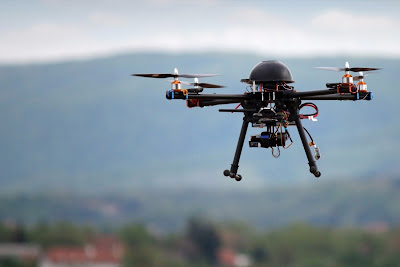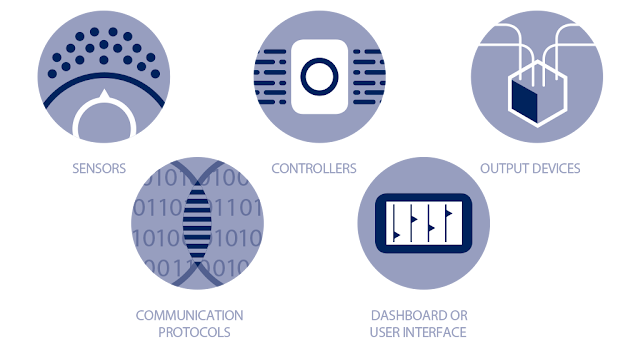Security
Industry Predictions for 2020
Wishing you a very Happy New Year.
Some
trends observed by the security and surveillance sector are Artificial
Intelligence, Cloud Computing, Cybersecurity, Sensor, integration.
According
to annual reports from the Ministry of Electronics and Information Technology.
In 2016-17, while the reported incidents stood at 35,418, in 2017-18 there were
69,539 incidents, rising to 274,465 in 2018-19. India reported slightly more
than 313,000 cybersecurity incidents in the ten months to October. The
country is plagued with weak e-infrastructure and is not capable of meeting the
needs of a growing economy and its population. Corporate growth and investments
can be hampered if the government fails to close the e-infrastructure deficit.
E-Infrastructure. E-Infrastructure comprises tools, facilities and resources
that are needed for advanced collaboration and includes the integration of
various technologies such as the Internet, computing power, bandwidth
provisioning, data storage etc.
Some trends observed in the security and surveillance sector are Artificial Intelligence, Cloud Computing, Cybersecurity and integration. Intellectual property (IP)-based surveillance technology, touted as the future of surveillance systems, has replaced closed-circuit analogue systems. Some trends like sensors, biometrics, real-time connectivity, advanced processing software and analytics have also propelled the industry growth. Some of these trends have enhanced the efficacy of security systems, whereas others have the potential of having adverse impacts.
Some trends observed in the security and surveillance sector are Artificial Intelligence, Cloud Computing, Cybersecurity and integration. Intellectual property (IP)-based surveillance technology, touted as the future of surveillance systems, has replaced closed-circuit analogue systems. Some trends like sensors, biometrics, real-time connectivity, advanced processing software and analytics have also propelled the industry growth. Some of these trends have enhanced the efficacy of security systems, whereas others have the potential of having adverse impacts.
Common
prediction themes across vendors include the 2020 elections in the U.S., more
targeted ransomware, more ways to attack the cloud, and an explosion of
problems with deepfake technology.
There’s
disagreement on the most important cyber threats to focus on as we head into
2020, even though everyone agrees that cybersecurity is more important than
ever before. Cyber-attacks of all kinds have become, and will continue to be, a
major threat, making this one of the most important initiatives that today’s
businesses embrace. From a manufacturer’s perspective, building cybersecurity
into the product from its inception is critical, with integrators beginning to
demand this level of consideration from the products they sell. As a result of
a rise in the convergence of IT applications alongside security investments,
end users are now seeking out solutions designed with data security
top-of-mind. As HikVision, Dahua named Chinese product already ban in various
sector globally including under umbrella brand. All network connected devices
such as DVRs/NVRs, servers, IP cameras, access controllers, intrusion alarms,
smart sensors, are vulnerable, which is why this added step in developing
cybersecurity protocols and applying them across the organization is critical.
The
Internet of Things (IoT) has been a major trend for the past few years in many
industries, and this will continue as we integrate sensors of all kinds into
the network. The collection and analysis of the data collected by these sensors
is giving rise to a plethora of applications such as industrial applications,
intelligent building management, event management, and much more. The physical
security industry benefits by having additional intelligence for situational
awareness and emergency management, as well as opportunities to provide
additional value-added services and business insights. Being deployed in an
increasing number of scenarios and with continued improvements in computing
capabilities, video has the opportunity to become the eye of IoT.
For 2020,
AI does show up again in a number of new ways — with several specific warnings
for those who fail to use AI to counter bad actors who will be using it. Software
manufacturers are looking toward artificial intelligence to help propel
advanced analytics in an effort to deliver more situational awareness to
operators, and an increased ability to proactively assess threats or anomalies.
While video and data analytic capabilities have been around for quite some
time, some would argue they were rudimentary in comparison to software that
uses AI to make existing applications such as facial recognition much more
accurate, and to create new ways to detect anomalies. In addition, AI continues
to be used to make sense of the large amounts of data that are being generated
by intelligent sensors and by analyzing the growing amount of video.
Businesses and other
organisations could face multimillion-pound fines if they are unable to explain
decisions made by artificial intelligence, under plans put forward by the UK’s
data watchdog in Nov 2019. The Information Commissioner’s Office (ICO) said its new
guidance was vital because the UK is at a tipping point. where
many firms are using AI to inform decisions for the first time. This could
include human resources departments using machine learning to shortlist job
applicants based on analysis of their CVs. The regulator says it is the first
in the world to put forward rules on explaining choices taken by AI.
Are we still talking about robots as a threat to jobs? According to
Google Trends data, automation remains a controversial topic. “Are robots
taking over jobs” is peaking at a similar search volume as ten years ago — but
a new concept is changing the role of automation in the workplace.
Augmented intelligence is one of the few technologies named on the Gartner Hype Cycle for Emerging Technologies, 2019 that are predicted to reach expectations, over the next
two-to-five years. In contrast to artificial intelligence (AI), augmented
intelligence emphasises collaborations between AI and human workers. It’s
designed to enhance human skills and allow them to work faster and more
efficiently, rather than replace them.
In
contrast to artificial intelligence (AI), augmented intelligence emphasises
collaborations between AI and human workers. It’s designed to enhance human
skills and allow them to work faster and more efficiently, rather than replace
them. That said, while advanced AI can fix some issues automatically, the
process is not always devoid of human intervention. Other issues, such as
emergency maintenance of a machine, will always require human involvement at
some stage. AI can provide the alert, but it can’t always do the work.
Cloud and Mobile Capabilities
Mobility
is critical for physical security and is emerging through the development and
use of cloud-based services, as well as the ability to access security devices
through a smart phone or Web-based browser. That’s why there’s been such an
influx of mobile apps created to manage cameras, receive automatic
alerts for the most diverse event, and giving users the ability to grant or
restrict access to a facility. All of this demonstrates the world’s demand for
mobility, connectivity and ease-of-use.
I believe
there will be a data breach to end all data breaches, and it will happen in the
cloud and affect billions of users. Chances are it will happen to a hybrid
cloud that will lead the hackers down a rabbit hole that will gain them access
to multiple cloud entities. This breach will cause a fundamental shift in how
cloud providers handle security; look for serious changes to the authentication
process of cloud providers by the end of the year.
2020 is the year 5G goes
mainstream. It’s safe
to say that 5G will revolutionize the way people stay connected to the
internet. Extra speed, extra bandwidth are going to make our mobile devices
faster, more powerful and hyperconnected, with the same thing happening to IoT
connected devices such as cameras. This is going completely change the way we
think about smart cities: More powerful IP devices connected to one another,
powered by AI, will have a massive impact on the way we move, shop and live in
urban areas.
2020 will be the year when we would see 5G emerging as a household network technology in many markets around the globe. Australia, Argentina, Canada, and Japan are amongst the key countries where the next-generation wireless technology is set to debut in the coming months.
2020 will be the year when we would see 5G emerging as a household network technology in many markets around the globe. Australia, Argentina, Canada, and Japan are amongst the key countries where the next-generation wireless technology is set to debut in the coming months.
Drones Open up New Pathway for Intelligence Gathering
To date,
the security concern around drones has mostly been focused on the physical
damage nefarious actors, including nation states, could perpetrate. In 2020, we
could start seeing attackers focus more on what drones know and how that
information can be exploited for intelligence gathering, corporate espionage
and more.
Military usage of drones or RPAS (Remotely Piloted Aerial Systems) has become the primary use in today's world. Used as target decoys, for combat missions, research and development, and for supervision, drones have been part and parcel of military forces worldwide.
Military usage of drones or RPAS (Remotely Piloted Aerial Systems) has become the primary use in today's world. Used as target decoys, for combat missions, research and development, and for supervision, drones have been part and parcel of military forces worldwide.
Video — Everywhere
Video is
the cornerstone of security, providing both real-time and forensic coverage for
emerging threats and incidents, which is why it’s one of the fastest growing
segments of the marketplace. The use of video for traditional applications in
new markets, as well as for use in newer applications that are not necessary
security related is poised to see the most movement. In some industries such as
oil and gas, there is a trend towards extending video coverage into extremely
harsh and hazardous environments, so manufacturers are challenged to develop
appropriately certified equipment to meet a more stringent demand.
Manufacturing facilities such as food processing plants are also increasing
their use of video for training and compliance purposes to prevent incidents
such as food recalls that can be extremely costly for the business. Huge number Video footage destroy without viewing what camera saw. in this 2020 video auditing will start journey.
‘Auditing’
means 'seeing' what the cameras 'saw'. CCTV video footage should be audited
daily; several times a day if need be. Depending on the requirements, auditing
of CCTV footage of critical cameras on a daily basis must become an SOP.
Auditing will help relevant stakeholders to ‘discover’ the 'unknown'. Auditing
as an activity may be manual, it may be post-facto, but it is a very dedicated
and systematic process, which helps address some of the challenges of live
monitoring (video blindness, poor attention span, boredom, bias, fatigue etc.),
as well as the challenges related to alert-based systems (how often has one
faced false alerts, or what is called the ‘cry-wolf’ effect). Auditing will
help discover issues as mentioned above as well as in identifying and analysing
threats and hazards (THIRA/HIRA) of various kinds. Auditing CCTV video footage
will also be extremely helpful in waste reduction and following the 5S
philosophy, i.e. sort, set, shine, standardize and sustain (all part of Six
Sigma practices). It’s an exciting
time to be a part of the security market, as we’re really just beginning to see
that, when it comes to technology advancements, the sky is the limit. I would
argue at the core of these innovations is the video data being collected, and
as we work to build technologies that can harness the power of these
applications, we will continue to be at the forefront of this movement toward
greater intelligence and business insights.
The
Indian security market is experiencing unprecedented boom due to huge demand.
The growing awareness in the retail and enterprise segment is giving security
solutions a cult status. A new phase of the consolidation process is on in the
Indian security market.












